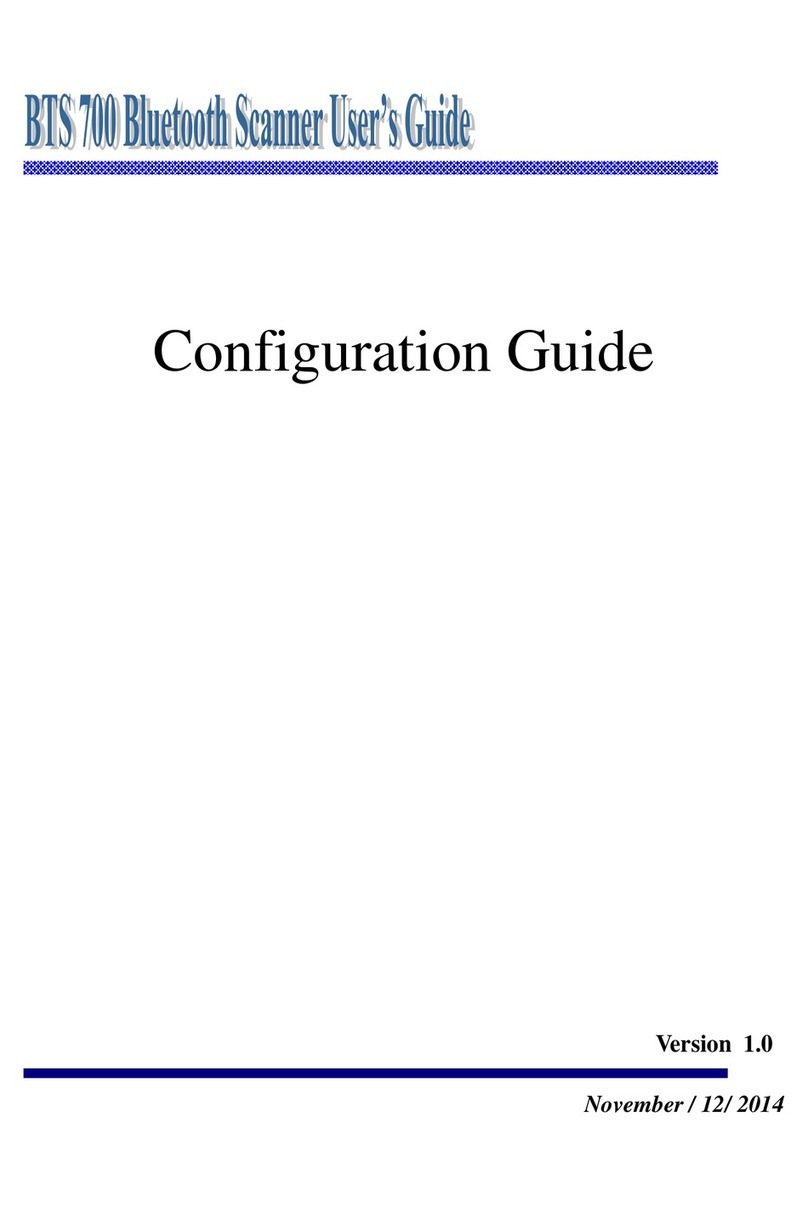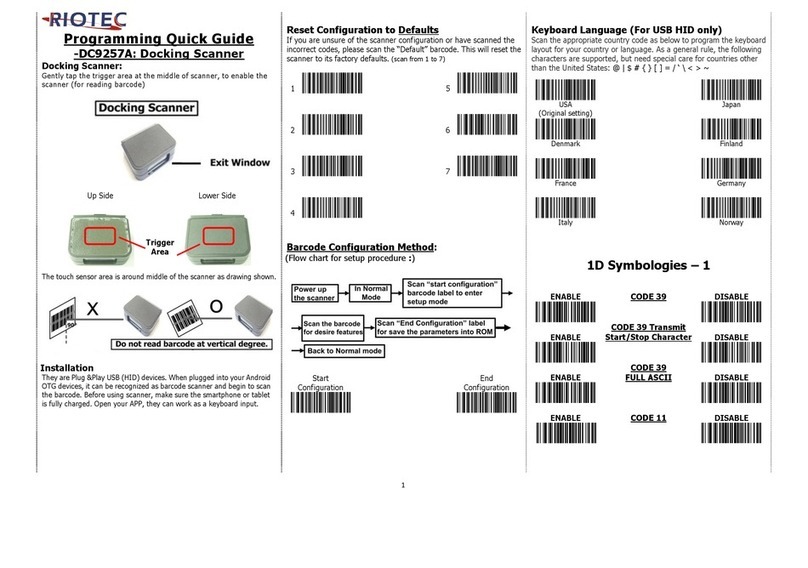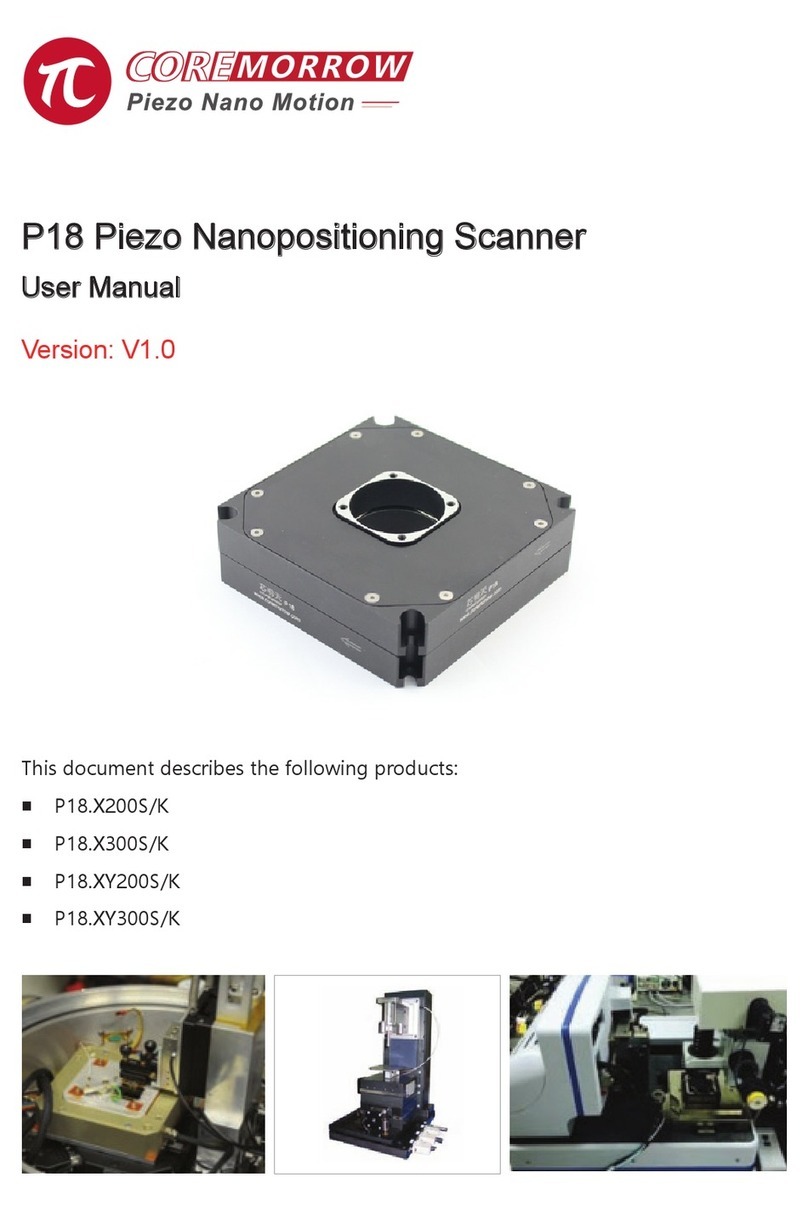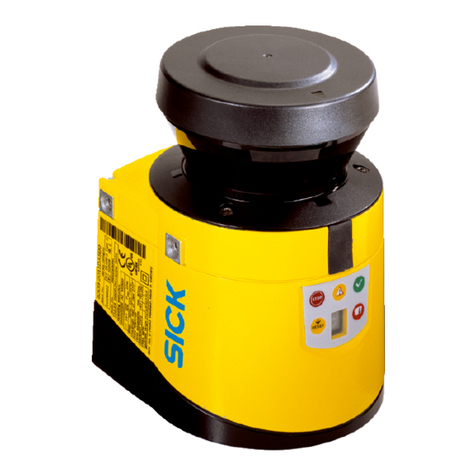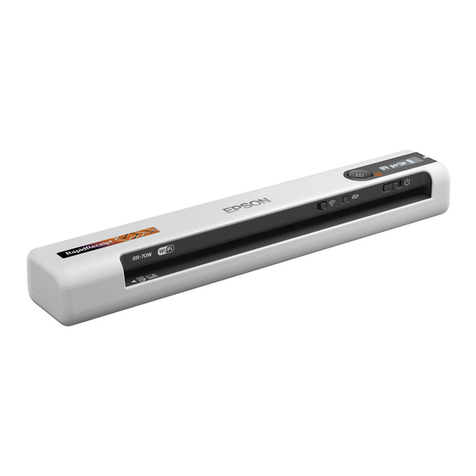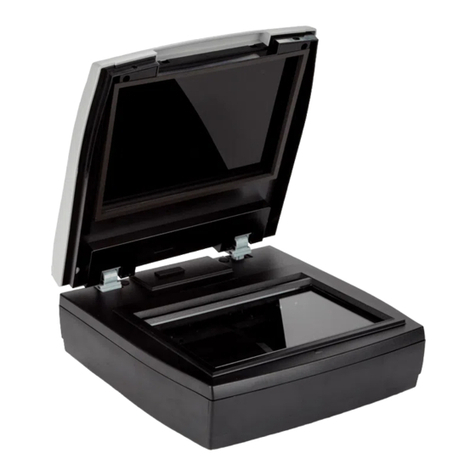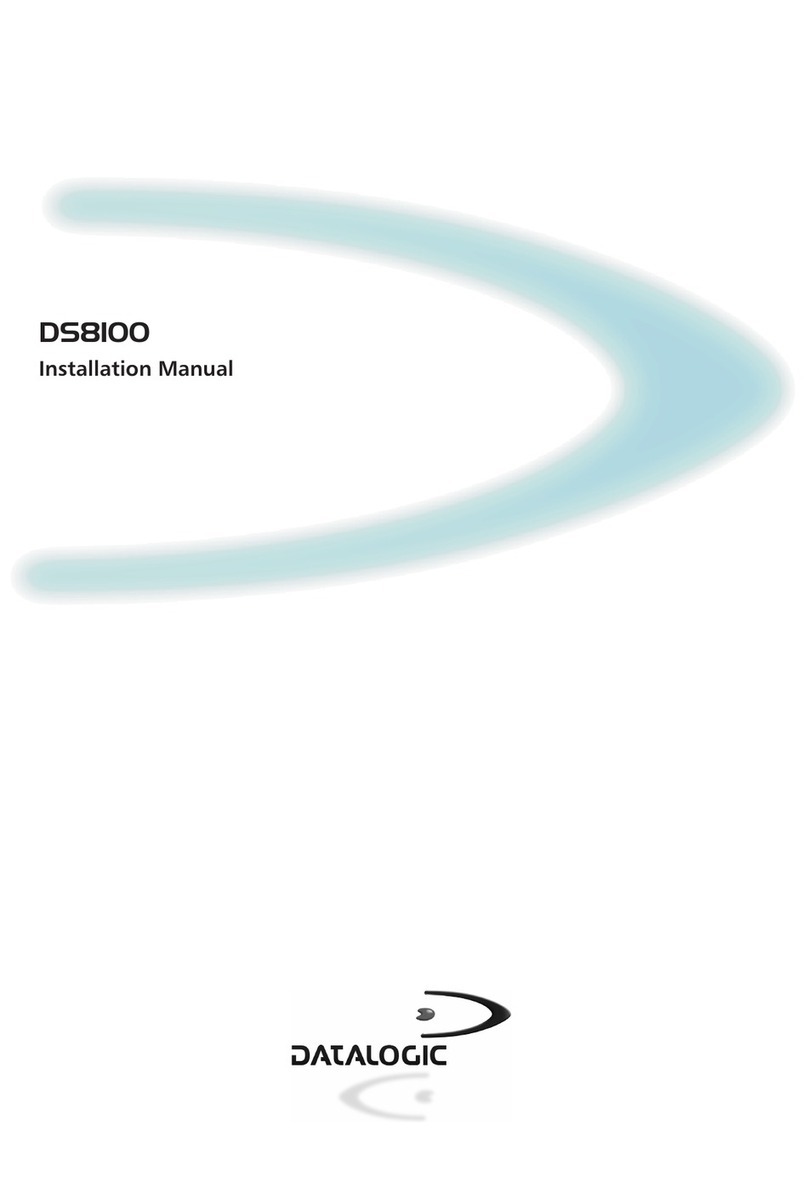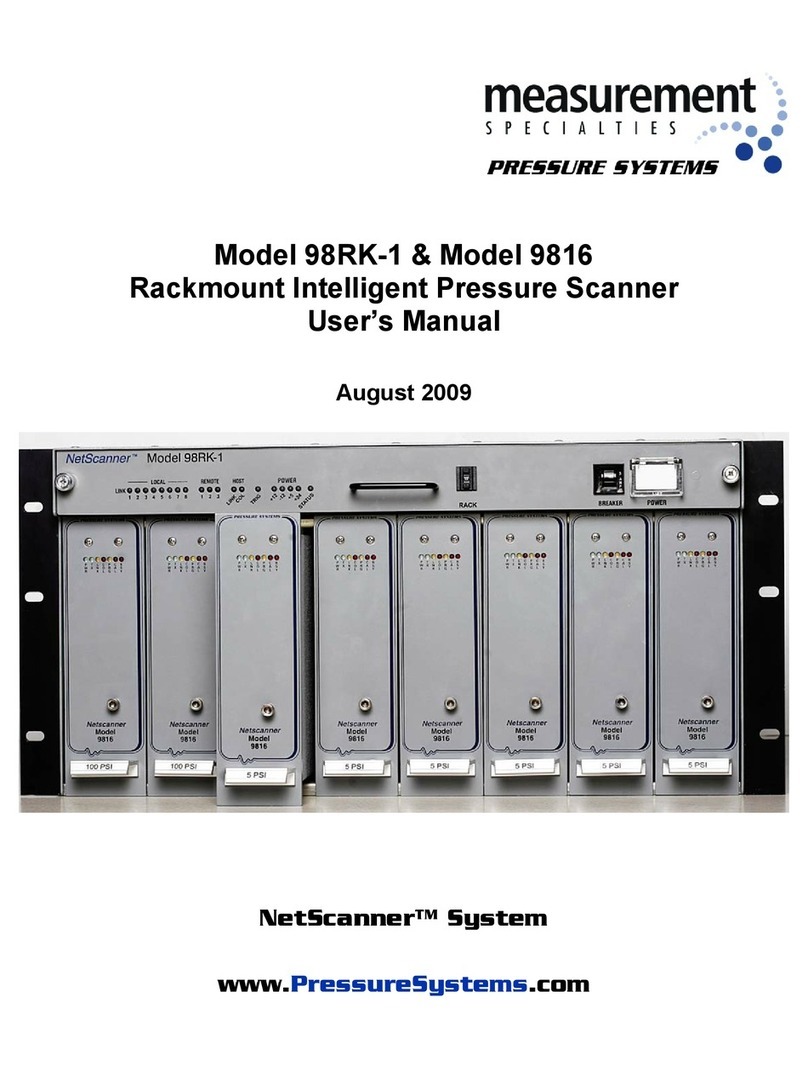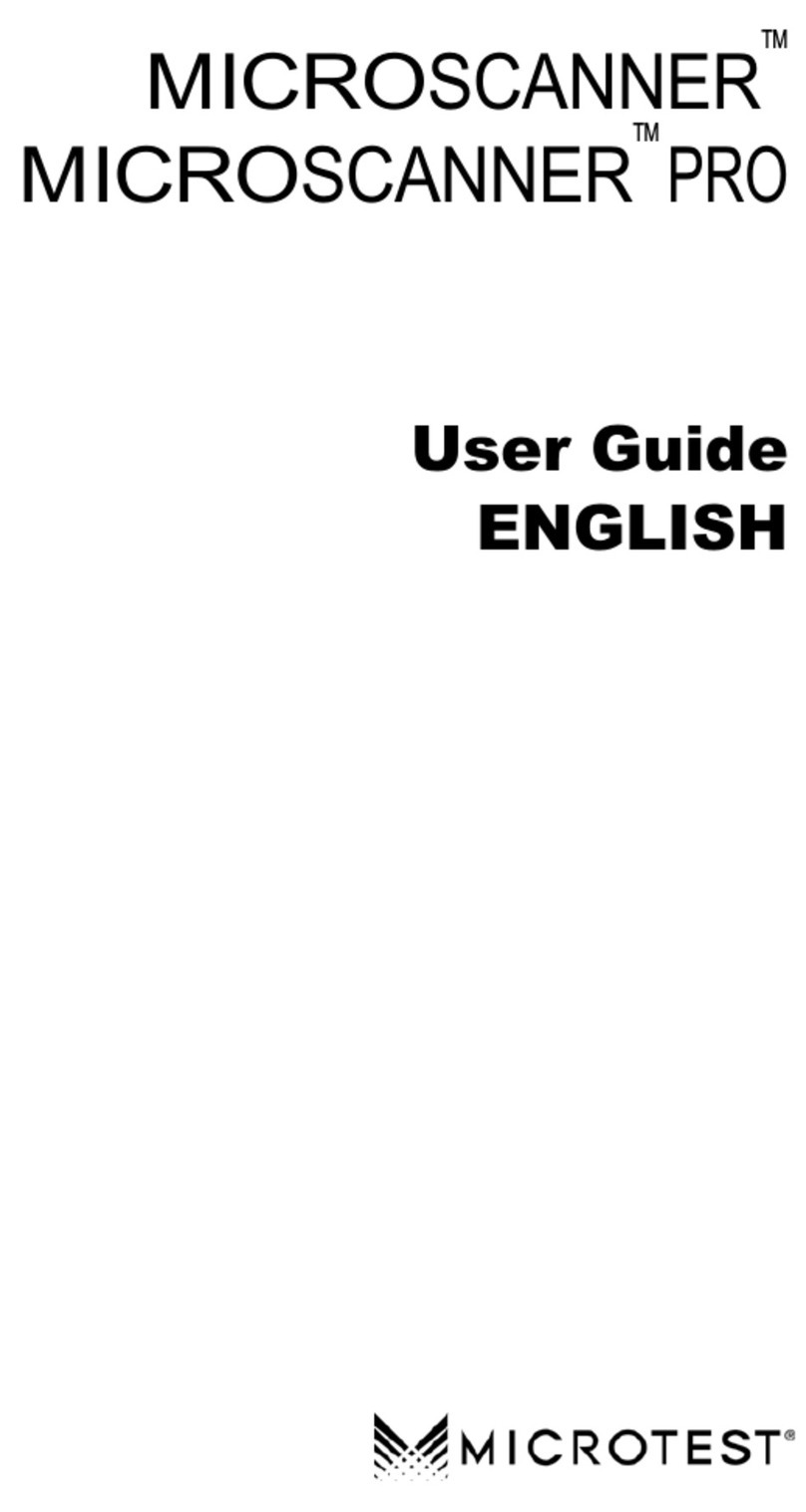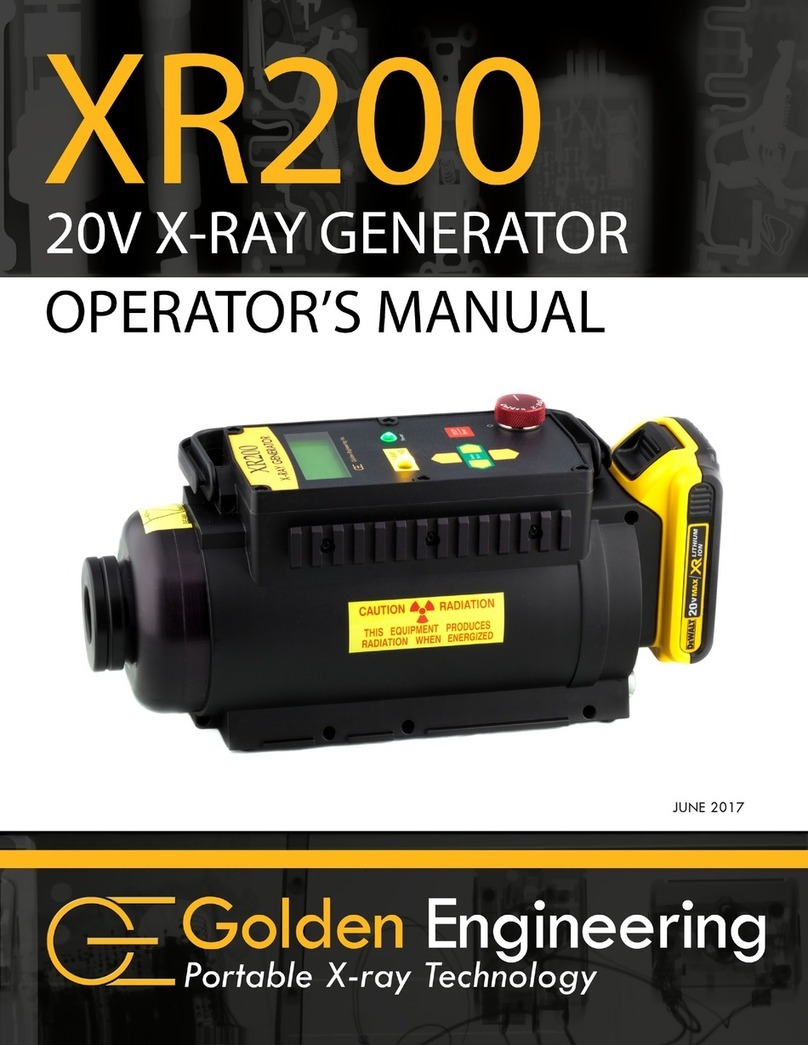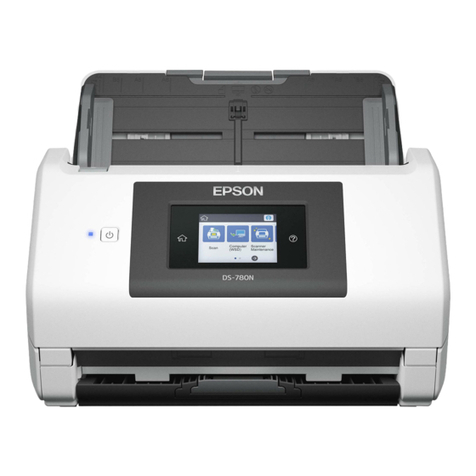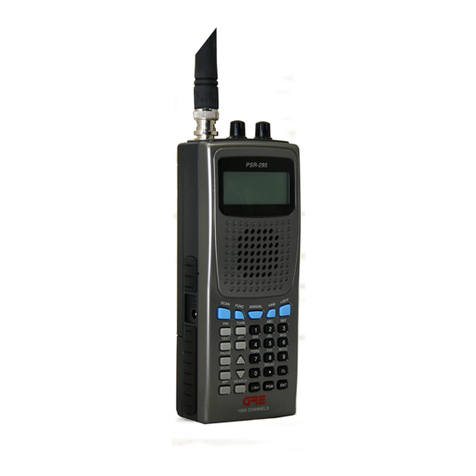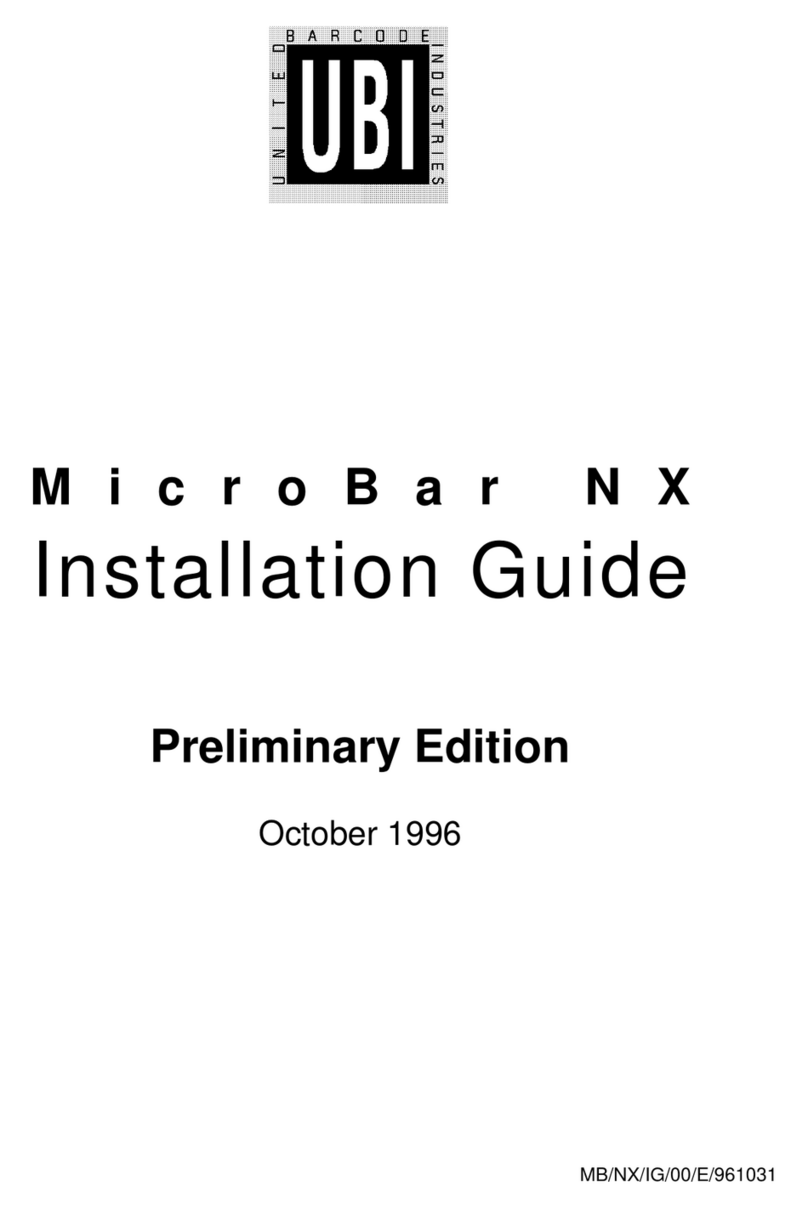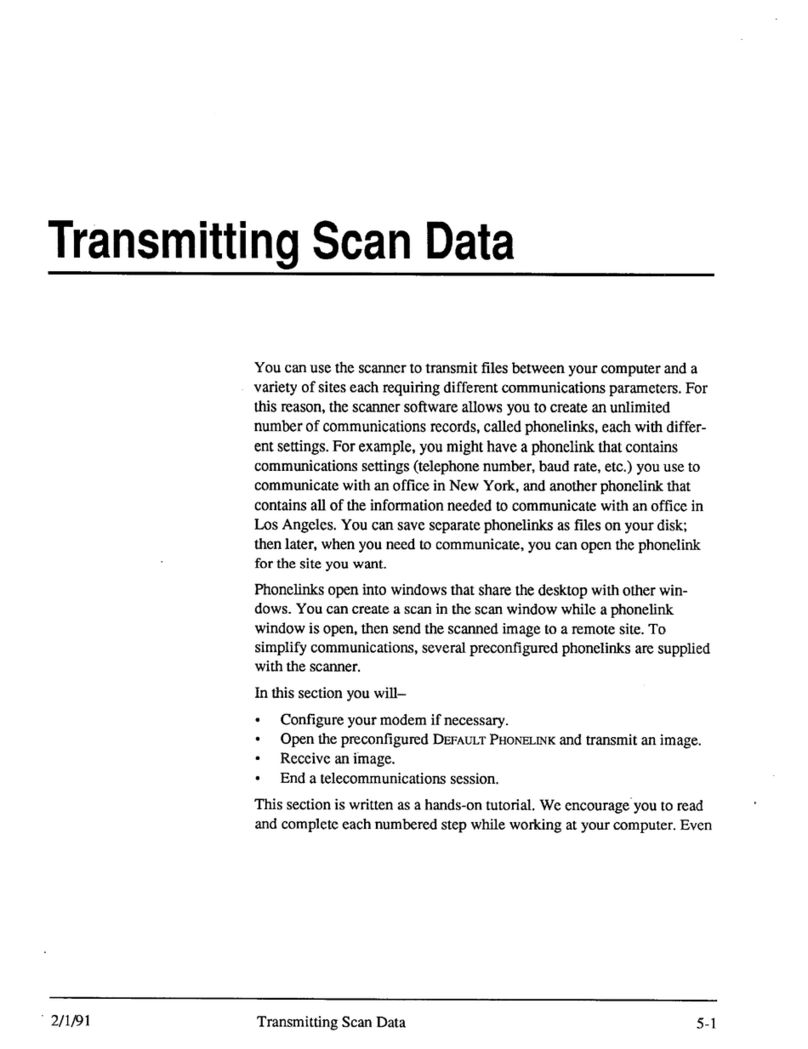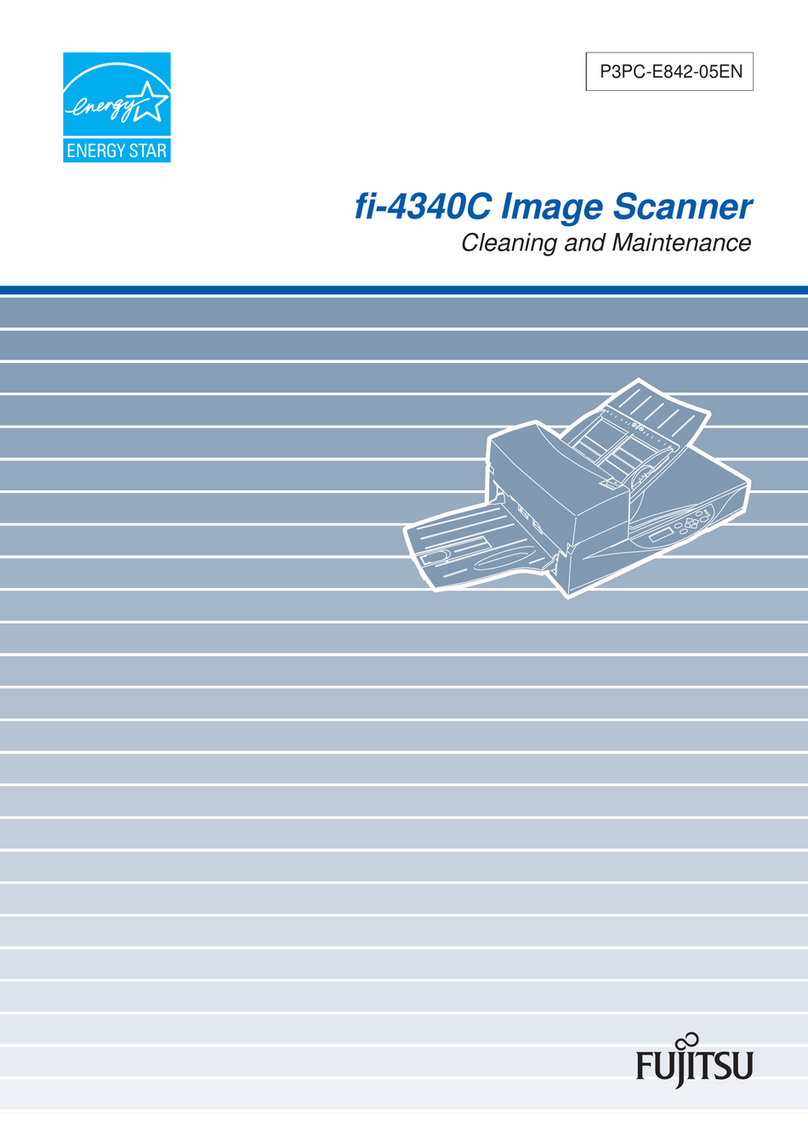Printronix SV 2 Series Manual

SV 2 Series
Scanner/Verifier
Operator’s Guide
P/N 254764-001

i
Table of Contents
PREFACE ...................................................................................................................................................... 5
WARRANTY................................................................................................................................................. 7
INTRODUCTION.......................................................................................................................................... 8
LASER BEAM............................................................................................................................................... 8
RESET BUTTON........................................................................................................................................... 9
Turn Off Laser Beam.................................................................................................................................. 9
Perform Calibration.................................................................................................................................... 9
Reset Ports.................................................................................................................................................. 9
I/O CONNECTOR........................................................................................................................................ 9
+ 5 VDC Power Input................................................................................................................................. 9
Sync Inputs............................................................................................................................................... 10
Edge Sync Mode................................................................................................................................... 11
Envelope Sync Mode............................................................................................................................ 11
Communication Sync Commands........................................................................................................ 12
Output Ports.............................................................................................................................................. 12
SYSTEM DISPLAYS.................................................................................................................................. 12
Power (Sync) LED ................................................................................................................................... 12
Calibration LED ....................................................................................................................................... 12
Read LED................................................................................................................................................. 12
Indicator LED’s 1 and 2........................................................................................................................... 12
SERIAL PORT CONNECTOR.................................................................................................................... 13
Serial Port Specifications ......................................................................................................................... 13
Serial Port Pin-out .................................................................................................................................... 13
SERIAL PORT TRANSMISSION FORMAT............................................................................................. 13
INSTALLATION AND SETUP.................................................................................................................. 15
Scanner Positioning.................................................................................................................................. 16
Bar Code Travel Direction ....................................................................................................................... 17
Bar Code Travel Speed Considerations.................................................................................................... 17
Picket Fence Direction.......................................................................................................................... 17
Ladder Direction................................................................................................................................... 18
Setting Ladder Mode Scanning Length Using ScanVision Software....................................................... 18
Calibration................................................................................................................................................ 18
Setup Procedure........................................................................................................................................ 19
Adjusting Scanner Gain and Offset.......................................................................................................... 21
TECHNICAL SPECIFICATIONS............................................................................................................... 22
Physical .................................................................................................................................................... 22
Environmental .......................................................................................................................................... 22
MTBF....................................................................................................................................................... 22
Laser Scanner........................................................................................................................................... 22
Scanning Performance.............................................................................................................................. 22
Scanner Options ....................................................................................................................................... 22
Power........................................................................................................................................................ 23
Sync.......................................................................................................................................................... 23
Outputs..................................................................................................................................................... 23
SYMBOLOGIES.......................................................................................................................................... 23
OPERATION MODES ................................................................................................................................ 23
Sync Mode – Moving Bar Codes ............................................................................................................. 23
Sync Mode – Stationary Bar Codes.......................................................................................................... 25
No Sync – Free Scan Operation ............................................................................................................... 25
PARAMETERS ANALYZED..................................................................................................................... 25
SV COMMAND LANGUAGE.................................................................................................................... 26
Data Match Commands – B...................................................................................................................... 26
Diagnostic Commands - D ..................................................................................................................... 29
Hardware Configuration Commands - H................................................................................................ 30
Label Setup Commands - L.................................................................................................................... 32

ii
Output Mode Selection Commands - O.................................................................................................. 37
Output Port Setup Commands - P........................................................................................................... 37
System Control Commands - S .............................................................................................................. 40
OUTPUT INTERFACE MODES DESCRIPTIONS ................................................................................... 45
Mode 00 (~LV00)..................................................................................................................................... 45
Mode 01 (~LV01)..................................................................................................................................... 45
Mode 02 (~LV02)..................................................................................................................................... 47
Mode 03 (~LV03)..................................................................................................................................... 49
Mode 12 (~LV12)..................................................................................................................................... 49
Mode 16 (~LV16)..................................................................................................................................... 51
Mode 17 (~LV17)..................................................................................................................................... 53
Mode 18 (~LV18)..................................................................................................................................... 55
Mode 19 (~LV19)..................................................................................................................................... 58
Mode 20 (~LV20)..................................................................................................................................... 60
ANSI PARAMETER GRADE THRESHOLDS.......................................................................................... 61
APPENDIX A; SV 2 SERIES SETUP HINTS............................................................................................ 62
Introduction.............................................................................................................................................. 62
Setting the Proper Scan Distance.............................................................................................................. 62
Setting the Proper Scan Angle.................................................................................................................. 63
Calibration Hints ...................................................................................................................................... 66

254764-001 Rev B 1
Software License Agreement
Your printer contains, among other software, Printronix operating software including, but not
limited to the Embedded Configurable Operating System (the “eCos Software”) as embedded
software. The terms of this Agreement apply only to the eCos Software, and all other embedded
software supplied with the printer. You accept the terms of this Agreement by your initial use of
your printer.
Object Code License
Printronix grants you a nonexclusive license to use the Printronix Software, the eCos Software
and all other embedded software (collectively, the “Embedded Software” or the “Software”) only in
conjunction with the printer. As the rightful possessor of the printer, you may make a reasonable
number of copies of the Software as necessary for backup, configuration, and restoration of the
printer. You must reproduce the copyright notice and any other legend of ownership on each copy
of the Software you make.
You may transfer possession of the Software and its media to another party only with the transfer
of the printer on which the Software is used. If you do so, you must give the other party a copy of
these terms and provide all user documentation to that party. When you do so, you must destroy
any copies of Software not resident in the printer.
Your license for the Software terminates when you no longer rightfully possess the printer. No
other rights under this license are granted.
Source Code
A source code version of eCos Software is available under the terms of the Red Hat eCos Public
License v1.1 at www.printronix.com. Printronix grants no rights whatsoever in the source code for
the Printronix Software.
No Warranty
THE EMBEDDED SOFTWARE IS PROVIDED UNDER THIS LICENSE ON AN “AS IS” BASIS,
WITHOUT WARRANTY OF ANY KIND, EITHER EXPRESSED OR IMPLIED, INCLUDING,
WITHOUT LIMITATION, WARRANTIES THAT THE EMBEDDED SOFTWARE IS FREE OF
DEFECTS, MERCHANTABLE, FIT FOR A PARTICULAR PURPOSE OR NON-INFRINGING.
THE ENTIRE RISK AS TO THE QUALITY AND PERFORMANCE OF THE EMBEDDED
SOFTWARE IS WITH YOU. SHOULD ANY OF THE EMBEDDED SOFTWARE PROVE
DEFECTIVE IN ANY RESPECT, YOU (NOT RED HAT, PRINTRONIX, ANY OTHER
CONTRIBUTOR OR ANY DISTRIBUTOR) ASSUME THE COST OF ANY NECESSARY
SERVICING, REPAIR OR CORRECTION. THIS DISCLAIMER OF WARRANTY CONSTITUTES
AN ESSENTIAL PART OF THIS LICENSE. NO USE OF ANY OF THE EMBEDDED SOFTWARE
IS AUTHORIZED HEREUNDER EXCEPT UNDER THIS DISCLAIMER.
Conflicting Terms
You agree that this Agreement provides you no more rights with regards to warranty, support,
indemnity or liability terms with respect to Red Hat, Inc., Printronix Inc, or any contributor to the
Embedded Software than that provided by the Red Hat eCos Public License v.1.1 or any express
warranty that may be made by Printronix, Inc.
Limitation of Liability
UNDER NO CIRCUMSTANCES AND UNDER NO LEGAL THEORY, WHETHER TORT
(INCLUDING NEGLIGENCE), CONTRACT OR OTHERWISE, SHALL RED HAT, PRINTRONIX,
ANY OTHER CONTRIBUTOR, OR ANY DISTRIBUTOR OF THE EMBEDDED SOFTWARE, OR
ANY PART THEREOF, OR ANY SUPPLIER OF ANY OF SUCH PARTIES, BE LIABLE TO YOU
OR ANY OTHER PERSON FOR ANY INDIRECT, SPECIAL, INCIDENTAL, OR
CONSEQUENTIAL DAMAGES OF ANY CHARACTER INCLUDING, WITHOUT LIMITATION,
DAMAGES FOR LOSS OF GOODWILL, WORK STOPPAGE, COMPUTER FAILURE OR

254764-001 Rev B 2
MALFUNCTION. OR ANY AND ALL OTHER COMMERCIAL DAMAGES OR LOSSES, EVEN IF
SUCH PARTY SHALL HAVE BEEN INFORMED OF THE POSSIBILITY OF SUCH DAMAGES.
THIS LIMITATION OF LIABILITY SHALL NOT APPLY TO LIABILITY FOR DEATH OR
PERSONAL INJURY RESULTING FROM SUCH PARTY’S NEGLIGENCE TO THE EXTENT
APPLICABLE LAW PROHIBITS SUCH LIMITATION. SOME JURISDICTIONS DO NOT ALLOW
THE EXCLUSION OR LIMITATION OF INCIDENTAL OR CONSEQUENTIAL DAMAGES SO
THAT EXCLUSION AND LIMITATION MAY NOT APPLY TO YOU.
U.S. Government Users
The Embedded Software is a “commercial item,” as that term is defined in 48 C.F.R. 2.101 (Oct
1995), consisting of “commercial computer software” and “commercial computer software
documentation,” as such terms are used in 48 C.F.R 12.212 (Sept. 1995). Consistent with 48
C.F.R. 12.212 and 48 C.F.R. 227.7202-1 through 227.7202-4 (June 1995), all U.S. Government
End Users acquire Covered Code with only those rights set forth herein.
Miscellaneous
This Agreement represents the complete agreement concerning subject matter hereof. If any
provision of this Agreement is held to be unenforceable. This Agreement shall be governed by
California law provisions (except to the extent applicable law, if any, provides otherwise),
excluding its conflict-of-law provisions.
Red Hat Statement With Regards to eCos Software
Part of the software embedded in this product is eCos - Embedded Configurable Operating
System, a trademark of Red Hat. Portions created by Red Hat are Copyright (C) 1998, 1999,
2000 Red Hat, Inc.
(http://www.redhat.com). All Rights Reserved.
THE SOFTWARE IN THIS PRODUCT WAS IN PART PROVIDED BY RED HAT AND ANY
EXPRESS OR IMPLIED WARRANTIES, INCLUDING, BUT NOT LIMITED TO, THE IMPLIED
WARRANTIES OF MERCHANT ABILITY AND FITNESS FOR A PARTICULAR PURPOSE ARE
DISCLAIMED. IN NO EVENT SHALL THE AUTHOR BE LIABLE FOR ANY DIRECT, INDIRECT,
INCIDENTAL, SPECIAL, EXEMPLARY, OR CONSEQUENTIAL DAMAGES (INCLUDING, BUT
NOT LIMITED TO, PROCUREMENT OR SUBSTITUTE GOODS OR SERVICES; LOSS OF
USE, DATA, OR PROFITS; OR BUSINESS INTERRUPTION) HOWEVER CAUSED AND ON
ANY THEORY OF LIABILITY, WHETHER IN CONTRACT, STRICT LIABILITY, OR TORT
(INCLUDING NEGLIGENCE OR OTHERWISE) ARISING IN ANY WAY OUT OF THE USE OF
THIS SOFTWARE, EVEN IF ADVISED OF THE POSSIBLITY OF SUCH DAMAGE.
Limited Software Product Warranty
Printronix, Inc. warrants that for ninety (90) days after delivery, the Software will perform in
accordance with specifications published by Printronix, Inc. Printronix, Inc. does not warrant that
the Software is free from all bugs, errors and omissions.
Remedy
Your exclusive remedy and the sole liability of Printronix, Inc. in connection with the Software is
replacement of defective software with a copy of the same version and revision level.
Disclaimer of Warranties and Limitation of Remedies
THE PARTIES AGREE THAT ALL OTHER WARRANTIES, EXPRESS OR IMPLIED,
INCLUDING WARRANTIES OF FITNESS FOR A PARTICULAR PURPOSE AND
MERCHANTABILITY ARE EXCLUDED. Printronix, Inc. does not warrant that the functions
contained in the Software will meet your requirements or that the operation of the Software will be

254764-001 Rev B 3
uninterrupted or error free. Printronix, Inc. reserves the right to make changes and/or
improvements in the Software without notice at any time.
IN NO EVENT WILL PRINTRONIX, INC. BE LIABLE FOR LOST PROFITS, LOST DATA,
BUSINESS INTERRUPTIONS, OR ANY OTHER DIRECT, INDIRECT, INCIDENTAL OR
CONSEQUENTIAL DAMAGES ARISING OUT OF THE USE OF OR INABILITY TO USE THIS
PRODUCT, EVEN IF PRINTRONIX, INC. HAS BEEN ADVISED OF THE POSSIBILITY OF
SUCH DAMAGES, OR ANY DAMAGES CAUSED BY THE ABUSE OR MANIPULATION OF
THE SOFTWARE. SOME STATES DO NOT ALLOW THE EXCLUSION OR LIMITATION OF
LIABILITY FOR CONSEQUENTIAL OR INCIDENTAL DAMAGES, SO THE ABOVE LIMITATION
MAY NOT APPLY TO YOU.
Printronix, Inc. will not be liable for any loss or damage caused by delay in furnishing a Software
Product or any other performance under this Agreement.
Our entire liability and your exclusive remedies for our liability of any kind (including liability for
negligence except liability for personal injury caused solely by our negligence) for the Software
Product covered by this Agreement and all other performance or nonperformance by us under or
related to this Agreement are limited to the remedies specified by this Agreement.
California law governs this Agreement.
Termination of License Agreement
This License shall continue until terminated. This license may be terminated by agreement
between you and Printronix, Inc. or by Printronix, Inc. If you fail to comply with the terms of this
License and such failure is not corrected within thirty (30) days after notice. When this License is
terminated, you shall return to the place you obtained them, the printer and all copies of the
Software and documentation.
U.S. Government Restricted Rights
Use, duplication or disclosure by the government is subject to restrictions as set forth in the
Rights in Technical Data and Computer Software clause at FAR 242.227-7013, subdivision (b) (3)
(ii) or subparagraph (c) (1) (ii), as appropriate. Further use, duplication or disclosure is subject to
restrictions applicable to restricted rights software as set forth in FAR 52.227-19 (c) (2).
Acknowledgement of Terms and Conditions
YOU ACKNOWLEDGE THAT YOU HAVE READ THIS AGREEMENT, UNDERSTAND IT, AND
AGREE TO BE BOUND BY ITS TERMS AND CONDITIONS. NEITHER PARTY SHALL BE
BOUND BY ANY STATEMENT OR REPRESENTATION NOT CONTAINED IN THIS
AGREEMENT. NO CHANGE IN THIS AGREEMENT IS EFFECTIVE UNLESS WRITTEN AND
SIGNED BY PROPERLY AUTHORIZED REPRESENTATIVES OF EACH PARTY. BY USING
THIS PRINTER, YOU AGREE TO ACCEPT THE TERMS AND CONDITIONS OF THIS
AGREEMENT.
This document contains proprietary information protected by copyright. No part of this document
may be reproduced, copied, translated or incorporated in any other material in any form or by any
means, whether manual, graphic, electronic, mechanical or otherwise, without the prior written
consent of Printronix, Inc.
Printronix, Inc. makes no representations or warranties of any kind regarding this material,
including, but not limited to, implied warranties of merchantability and fitness for a particular
purpose. Printronix shall not be held responsible for errors contained herein or any omissions
from this material or for any damages, whether direct, indirect, incidental or consequential, in
connection with the furnishing, distribution, performance or use of this material. The information in
this manual is subject to change without notice.

254764-001 Rev B 4
Trademark Acknowledgements
Microsoft and Windows are registered trademarks of Microsoft Corporation.
Printronix is a registered trademark of Printronix, Inc.
Copyright 2002, 2007, Printronix, Inc.

254764-001 Rev B 5
PREFACE
Proprietary Statement
This PRINTRONIX SV 2 Series Operator’s Guide contains proprietary information of PRINTRONIX. It is
intended solely for the use of parties operating and maintaining the equipment described herein. This
information may not be used, reproduced, or disclosed to any other parties for any other purpose without
the express written permission of PRINTRONIX.
FCC Notice
This device has been tested and found to comply with the limits for a Class B digital device, pursuant to
Part 15 of the FCC Rules. These limits are designed to provide reasonable protection against harmful
interference in a residential installation. This device generates, uses, and can radiate radio frequency energy
and, if installed and used in accordance with the instruction, may cause harmful interference to radio
communications. However, there is no guarantee that interference will not occur in a particular installation.
If this device does cause harmful interference to radio or television reception, the user is encouraged to try
to correct the interference by one or more of the following measures:
-Reorient or relocate the receiving antenna.
-Increase the separation between the computer and receiver.
-Connect the computer into an outlet on a circuit different from that to which the receiver is
connected.
-Consult the dealer or an experienced radio/TV technician for help.
Caution: Any changes or modifications not expressly approved by the grantee of this device could void the
user’s authority to operate the equipment.
Statement of FCC Compliance: Canada
This Class B digital apparatus meets all requirements of the Canadian interference-Causing Equipment
Regulations.
Cet appareil numénque de la classe B respecte toutes les exigences du Règlement sur le maténel brouilleur
du Canada.
CE:
The unit will contain cTUVus and/or CE quality assurance labels.
This equipment generates, uses, and can radiate radio frequency energy and, if not installed and used in
accordance with this operator’s manual, may cause harmful interference to radio communications.
Operating this equipment in a residential area is likely to cause harmful interference in which case the user
will be required to correct the problem at his own expense.
Statement of RoHS Compliance:
All SV 2 Series units with appropriate part numbers conform to requirements specified in DIRECTIVE
2002/95/EC OF THE EUROPEAN PARLIAMENT AND OF THE COUNCIL of 27 January 2003 on the
restriction of the use of certain hazardous substances in electrical and electronic equipment.
Use with Safety Agency-Listed Equipment (UL, TUV, VDE, etc)
The SV 2 Series should be used only with printers, applicators, etc. that are Safety Agency listed. The SV
2 Series is intended to be supplied by a Safety Agency Listed power supply (QQGQ) or (EPBU) or receives
power from the host unit (Printer), output rated 5Vdc, minimum 300mA maximum 1A.
Documentation Updates
PRINTRONIX strives to provide the best possible documentation. This manual, or any of our manuals,
may be updated without notice.

254764-001 Rev B 6
Laser Safety
•All SV models; IEC Class 2, CDRH Class II
Cautions
•Never stare directly into the laser beam.
•Never stare directly at a reflected image of the laser beam.
•Avoid exposure to the laser beam.
•Use of controls or adjustments or performance of procedures other than those specified herein may
result in hazardous radiation exposure.
•Use the SV 2 Series only with UL-Listed Bar Code Printers, Applicators, conveyors, etc.
•The following laser light Caution labels must be affixed to your SV 2 Series verifier: If they are not,
contact PRINTRONIX immediately.
Trademarks
The following are trademarks of PRINTRONIX Systems International:
•PRINTRONIX
•SV100
•SV 2 Series
Technical Support
Please read this manual before installing an SV 2 Series unit.
If you need assistance over the phone, please have the following information ready:
•Model and serial number of your unit
•Maintenance contract information (if you have a contract)
•Test or diagnostic printout if applicable
•Detailed explanation of the problem or question
•Your company’s phone and fax numbers
•Name of vender purchased from
Printronix, Inc.
14600 Myford Road
Irvine, CA 92623-9559
+1 (714) 368-2686 - Phone

254764-001 Rev B 7
Maintenance
The SV 2 Series is designed to provide maintenance free operation through its life and contains no moving
parts that require maintenance.
Cleaning
The output window should be kept clean by wiping it with a slightly dampened, soft cloth. Dampen with
water or a screen cleaner.
Customer Support Offices
Printronix, Inc.
14600 Myford Road
Irvine, CA 92623-9559
+1 (714) 368-2686 - Phone
WARRANTY
General Warranty
PRINTRONIX warrants the SV 2 Series to be free from defects in material and workmanship for a period
of 1 year, under normal use and service, from the date of shipment from PRINTRONIX’ factory location.
The liability of PRINTRONIX under this warranty is limited to repairing or replacing
the defective part and/or unit. PRINTRONIX may optionally choose to issue
credit for any unit returned during the warranty period.
You must promptly notify PRINTRONIX of any defect in order to receive the full protection of this
warranty.
Warranty Limitations
The warranty set forth above is exclusive and no other warranty, whether written or oral is expressed or
implied. PRINTRONIX specifically disclaims the implied warranties of merchantability and fitness for a
particular purpose.
PRINTRONIX is not liable for indirect or consequential damages incurred due to a warranted product’s
failure that brings about increased costs of doing business.
Service During the Warranty Period
If your SV unit should fail during the warranty period, contact PRINTRONIX or its authorized
representative immediately upon discovery of the defect. PRINTRONIX’ Customer Service Department
will provide you with a Return Authorization Number (RMA number).
You will be asked to ship the product in its original packing, freight prepaid, with the RMA number visibly
written on the outside of the carton to PRINTRONIX’ factory location.
Be sure to include any samples or printouts or other information that will help us to understand the problem.
Your repair will be given priority treatment, or your unit may be replaced at PRINTRONIX’ option. The
repaired item will be returned UPS/RPS ground, freight prepaid.
At your request PRINTRONIX will ship express or overnight if you need premium service and agree to pay
the additional cost.

254764-001 Rev B 8
INTRODUCTION
The PRINTRONIX SV 2 Series of Scanner/Verifiers is designed to be a universal system component that
can analyze linear bar code print quality, check encoded data and detect system failures. In its basic mode
of operation, an SV unit acts similar to a normal fixed position scanner by automatically decoding bar
codes as they pass through its laser beam. Additional capabilities such as performing bar code verification
and operating in synchronous modes make the SV 2 Series unique.
The SV 2 Series combines state-of-the-art digital signal processor (DSP) technology, a proprietary high-
speed moving beam laser scanner with unique analog output capability and flexible I/O and
communications capability. This powerful architecture enables an SV unit to be an economical Quality
Assurance tool for practically any bar code printing, applying or conveying system.
The SV 2 Series performs practically every accepted method of bar code verification – ANSI method,
traditional method, encoded data format checks and laser scanning type analyses. These wide-ranging
analysis parameters can be used to measure bar code quality and detect failure mechanisms for any print
technology.
Bar code quality and encoded data information can be reported through the serial communications port for
each code analyzed, therefore accountability for all bar codes printed is possible.
An SV Unit’s I/O consists of five programmable output ports, two programmable display LED’s and a sync
input (with two interface circuit choices.) This allows the unit to be used as a local controller for pausing
printers, activating lights, gating conveyors, etc.
The SV 2 Series is available in different models. All models operate identically, except the scanner
parameters such as scans per second and focus distance are different. Below is a matrix describing standard
available models.
SV 2 Series Version Specifications*
SV100-2 SV100HD-2 SV100C-2 SV200-1-2 SV200-2-2
Analyses/sec 100 100 100 200 200
Scan Width 6” (152mm) 4.5” (114mm) 10.5” (267mm) 2.5” (63.5mm) 1.75” (44mm)
Focus Distance 8” (203 mm) 6” (152mm) 15” (381mm) 8” (203mm) 6” (152mm)
X dim (min) .0067” (.17mm) .005” (.127mm) .013” (.33mm) .0067” (.17mm) .005” (.127mm)
* Contact PRINTRONIX Technical Support for information on custom and other models
The recommended setup tool for the SV 2 Series is PRINTRONIX ScanVision Windows based software.
This program makes SV setup simple via menus plus it offers real time monitoring of bar codes being
analyzed. This program is available at no charge from PRINTRONIX and authorized PRINTRONIX re-
sellers. ScanVision can be used to program the SV 2 Series via serial communication using SV Download
language. The language is described in this Operator’s Guide.
LASER BEAM
The laser beam may be on at any time the Power/Sync LED is illuminated.

254764-001 Rev B 9
RESET BUTTON
The Reset button is multifunctional.
Turn Off Laser Beam
The laser beam may be turned off (therefore turning off the SV unit’s scanning operation) by holding down
the Reset button for a few seconds until the beam turns off. Pressing the Reset button again will begin
normal scanning operation.
Note: there are some modes of operation when the laser beam is on only during specific scanning times
(see the ~SA Command in the SV Command Language Section.) Using the Reset Button for turning off the
system is not recommended in these modes.
Perform Calibration
The reset button is used in the calibration procedures. See the Calibration Section for details.
Reset Ports
Pressing the Reset button will reset ports to their inactive states. This is useful in systems where the SV unit
is holding a printer in PAUSE mode and the user desires to clear the pause condition. See the Output Ports
Section for details.
I/O CONNECTOR
The I/O connector is used for all power and field interconnections. The connector is a DB 15 male. Pin-outs
are shown below:
1 - Isolated synchronization input (+)
2 - Isolated synchronization input (-)
3 - GND
4 - Switch synchronization input
5 - Output Port 1
6 - Output Port 2
7 - Output Port 3
8 - Output Port 4
9 - Reserved
10 - Reserved
11 - GND
12 - +5 VDC power in
13 - Power GND
14 - GND
15 - Output Port 5
+ 5 VDC Power Input
The SV 2 Series requires + 5 Volts DC, +/- 0.25 Volt. Maximum current consumption is 1 amp. The
voltage input must be connected to pin 12 and the ground input should be connected to pin 13 on the I/O
connector.
The alternate ground pins (3, 11 and 14) may be used for power ground or for connecting the ground(s) of
an external device(s) (such as presence sensors) that may be powered from a different source than the
verifier power input.

254764-001 Rev B 10
Sync Inputs
Utilizing a sync signal is recommended for all applications using hardware (as opposed to communication)
interfaces. (Also see Operation Modes Section.) A sync signal is used to synchronize the SV 2 Series to an
object, label, etc. that contains the bar code(s) being analyzed as it passes through the laser beam. The SV 2
Series should be programmed for the number of bar codes expected per sync interval. This ensures a robust
system that can report all undetectable bar codes due to printer failure, missing labels, etc. along with
quality and data information on bar codes that are fully or partially decoded.
Two hardware sync inputs are available. Pin 4 is designed to be used with ttl or open collector inputs. For
open collector inputs, adding an external pull-up resistor to 5 VDC is recommended because the internal
pull-up is a relatively high 100 K ohm resistance. Pins 1 and 2 form a ground isolated input designed to be
used with systems that need separate grounds than the verifier and/or output a higher voltage level than ttl.
See figures C1 and C2 for circuit diagrams.
Figure C1 – ttl Sync Input Diagram
Figure C2 – Isolated Sync Input Diagram
Sync inputs are also available via serial communications. See the ~SK command for details.
Hardware sync operation is very flexible due to programmable options. Two sync modes – edge and
envelope – are available. Signal input polarity is also user programmable.
Please see the Operation Modes Section for more information on use of these sync modes.
+5 VDC
(
SV PSU
)
100K Ohm
Pin 4 To SV s
y
nc lo
g
ic
Pin 1
Pin 2
3.9 K oh
m
To SV sync logic
To SV sync logic

254764-001 Rev B 11
Edge Sync Mode
This mode senses a signal transition level of a sync signal as shown in Figure S1.
Sync sensed here
Figure S1 – Edge Sync
Figure S1 shows the sync operation of an SV unit programmed to sense the rising edge of a sync signal in
edge mode. Each time a rising edge is sensed, the SV unit does the following:
1. It verifies that at least the number of bar codes expected (programmed) since receiving the last
sync input have been fully decoded. If not, a No Read condition is internally set for possible
reporting through communication or output activation.
2. It begins a new interval, counting the bar codes analyzed until the next sync input is received.
3. A Serial communication report is transmitted and an output port is updated per its
programmed function each time a bar code is analyzed.
Envelope Sync Mode
This mode senses two (leading and trailing) transitions of the sync signal to determine when to begin and
end the period for determining missing bar codes as shown in Figure S2 below.
Sync period starts here
Sync period ends here
Figure S2 – Envelope Sync
Figure S2 shows the sync operation of an SV unit programmed to sense the rising voltage edge as the start
of a sync period. The SV unit operates in this mode as follows:
1. Upon receipt of the starting edge of a sync signal, the unit begins counting the bar codes being
scanned and analyzed.
2. A Serial communication report is transmitted and an output port is updated per its
programmed function each time a bar code is analyzed.
3. Counting ceases upon receipt of the trailing edge of a sync signal. The SV 2 Series determines
that at least the number of bar codes expected (programmed) during the sync period have been
fully decoded. If not, an internal No Read condition is set for possible reporting through
communication or output activation.
4. The SV unit then waits for the next leading edge of a sync signal to begin counting codes
being scanned and analyzed.
NOTE: In either sync mode, for best performance, mount the SV unit in a location where a bar code is
not in the laser beam when an active edge signal is received.

254764-001 Rev B 12
Communication Sync Commands
Sync operation can be accomplished through serial communications. Please see the ~SK command for
details.
Output Ports
Five programmable output ports are available on I/O connector pins 5, 6, 7, 8, and 15. Each port can be
programmed to activate on practically any combination of data and analysis parameters (including “good
codes”) analyzed by the SV 2 Series. Port activation logic and parameters are programmed via the output
interface modes and associated commands. See the Output Interface Modes Descriptions section for details.
Each port’s output is an open drain FET (field effect transistor). Therefore, the port can either be “ON”
(sinking current) or “OFF” (no current/open circuit.) The active polarity determines whether the port is
“ON” or “OFF” while active. This type of output circuit is used because it is flexible for field connections.
Figure C3 shows an example circuit diagram of one output port.
Figure C3 – Open Drain FET Output Diagram
SYSTEM DISPLAYS
Five LED’s are included on the SV 2 Series back panel.
Power (Sync) LED
This LED is illuminated green whenever power is applied to the SV 2 Series. Upon receipt of any sync
input (hardware or serial communications) the LED will blink red for approximately 100 milliseconds.
Calibration LED
This yellow LED indicates calibration status. Please refer to the Calibration Section for details.
Read LED
This green LED is illuminated whenever a bar code is being fully decoded.
Indicator LED’s 1 and 2
These two green LED’s are user programmable exactly like the five output ports. Their functions are
intended for use as indicators for specific analysis results.
A common example is LED 1 programmed to illuminate in latch mode whenever a symbol quality error is
detected, while LED 2 is programmed to illuminate in latch mode whenever a No Read error is detected.
To appropriate output pin 5, 6, 7, 8, or 15
To SV ground
From SV output logic

254764-001 Rev B 13
SERIAL PORT CONNECTOR
The serial port connector is used to interface the SV 2 Series with devices incorporating RS-232C signal
levels. The connector is a DB 9 male.
The serial port can be used for reporting bar code analysis results to a host and receiving SV Command
Language instruction from a host.
Serial Port Specifications
•Baud rate: programmable between 9600 and 115200 baud
•Protocol: Echo back
•Data: 8 bit, no parity, 2 stop bits
•RS 232C compatible
Serial Port Pin-out
Pin Function
2Receive Data (RXD)
3Transmit Data (TXD)
4Data Terminal Ready (DTR)
5Ground
7 Request to Send (RTS)
8 Clear to Send (CTS)
SERIAL PORT TRANSMISSION FORMAT
The following data transmission format is standard in the SV 2 Series. This is the format used by
ScanVision software for setup and monitoring of SV 2 Series data. All parameters analyzed for each bar
code scanned are transmitted in the following order:
YabbccddeeffgghhiijjkklmmnoopqqrsstttuuvwwwxxxxPPPPyyMNzzzzAAAABBB
CCCDDDEEFFGHHIIJJOKLL[bar code data chars]Z
Characters designated ‘a’ through ‘O’ represent values for Parameters analyzed which are described below.
For more parameter details, see the Parameters Analyzed Section.
Legal values for each parameter are;
Pos Chars Parameter
Y 1 1 Programmable ASCII character indicates start of transmit:
See ~SSbbbeee command. CR (carriage return) required for ScanVision.
a 2 1 P=PASS Ref Decode, F=FAIL per Ref Decode algorithm.
P and F are a majority decision over all scans
b 3 2 00-9A (0-100);
Decodability calc. avg. over all decoded scans
c 5 2 00-9A; Modulation calc. avg. over all decoded scans
d 7 2 00-9A; Defects calc. avg. over all decoded scans
e 9 2 00-9A; Edge Contrast calc. avg. over all decoded scans
f 11 2 00-9A; Rmin/Rmax calc. avg. over all decoded scans
g 13 2 00-9A; SymbolContrast calc. avg. over all decoded scans
h 15 2 00-9A; PCS calc. avg. over all decoded scans
i 17 2 00-9A; R(white) calc. avg. over all decoded scans

254764-001 Rev B 14
Pos Chars Parameter
j 19 2 00-9A; R(black) calc. avg. over all decoded scans
k 21 2 00-99; Ratio calc. avg. over all decoded scans
Example: 29 represents a ratio of 2.9
l 23 1 + or - indicating sign of avg. bar deviation calculation.
+ indicates wide bars.
m 24 2 Bar deviation calculation averaged over all decoded scans.
Units are % of X. Value: 00-9A (signify 0 – 100)
n 26 1 + or - indicating sign of avg. min. bar deviation calculation.
+ indicates wide bars.
o 27 2 Minimum bar deviation calculation averaged over all
decoded scans. Units are in % of X. Value: 00-9A (signify 0 –100)
p 29 1 + or - indicating sign of avg. max. bar deviation calculation.
+ indicates wide bars.
q 30 2 Maximum bar deviation calculation averaged over all
decoded scans. Units are in % of X. Value: 00-9A (signify 0 – 100)
r 32 1 One character: Pass(P) or Fail(F). Quiet Zone. Pass requires approx. 80% min.
of all scans on the code to have an acceptable quiet zone analysis. (Note: the
~PB816 command provides a programmable decision threshold for output port
manipulations.)
s 33 2 00-9A; Percent decode calc. avg. over all decoded scans
t 35 3 Absolute X dimension in 0.1 mil (.0001 inch) resolution.
Example: a value of 120 represents a 12 mil X dimension.
u 38 2 Overall ANSI method symbol grade (numeric) Ave over all decoded scans.
Example: 26 = 2.6
v 40 1 Bar code decoding direction: Forwards(0) or Backwards(1)
w 41 3 000-999; Calculated symbology mod check value, Code 93 mod check C
x 44 4 4 hex digits, records output count
P 48 4 4 hex digits; self check value
y*52 2 Two digit number identifies the symbology. See Symbology Identifier Table for
details.
M* 54 1 Digit: 0 = no error, 3 = symbology mod check error, 4 = subsymbology mod
check error, 1, 2, 6 , or 7 = partial decode error
N* 55 1 Digit; 0 = no error, 4 = data match field length error, 5 = data match and
Decrement error, 6 = data match and increment error, 7 = decrement error,
8 =increment error, 9 = data match error
z 56 4 Four digit number indicates bar code horizontal position.
A 60 4 Four digit number indicates bar code vertical position.
B 64 3 Three digit number shows good scans-on-code. (00-9A)
C 67 3 Three digit number shows total scans-on-code.
D 70 3 000-999; Good Quiet zones (scans).
E 73 2 Two digit number shows Lead QZ. Units: .1X (00-9A)
F 75 2 Two digit number shows Trail QZ. Units: .1X (00-9A)
G 77 1 One digit number: ‘0’ (off), ‘1’ (on). Sync state.
H 78 2 IGC, two bytes: Units of X dimension times 10. Value=00 when N/A
I 80 2 Two digits; Percent of good global Thresholds. (00-9A)
J 82 2 Two digits; Calculated application checksum value or Code 93 mod check K
O 84 1 One digit; indicates the subsymbology enabled in the y field of ~LFxy command
for this symbol. A value of 0 indicates no subsymbology check is enabled.
K 85 1 One digit; buffer overrun indication; 0=no overrun

254764-001 Rev B 15
Pos Chars Parameter
L 86 2 Two digits; decode header indicator “^^”
[chars] 88 … Bar code data characters (variable length).
Z last 1 Programmable ASCII character indicates end of transmit;
See ~SSbbbeee command. LF (line feed) required for ScanVision.
y*- The symbology identifiers use groups of numbers to identify each symbology. The range of
possible values could potentially span 100 for each symbology category. The Symbology Identifier Table
lists each identifier group with the corresponding symbology.
* A no read condition is indicated by all four bytes yy, M and N set to 0 in a transmission. All other
data is therefore not valid.
See the ~OS# command for other transmission data formats.
Symbology Identifier Table
Identifiers Symbology Category
02 I 2 of 5
03 Code 128
04 Code 93
05 Code 3 of 9
06 Codabar
11 UPC-A
15 UPC-A w/add-on (2)
19 UPC-A w/add-on (5)
12 EAN-13
16 EAN-13 w/add-on (2)
20 EAN-13 w/add-on (5)
13 EAN-8
17 EAN-8 w/add-on (2)
21 EAN-8 w/add-on (5)
14 UPC-E
18 UPC-E w/add-on (2)
22 UPC-E w/add-on (5)
INSTALLATION AND SETUP
Scanner positioning and proper system setup are extremely important for proper SV 2 Series operation. The
following sections describe the most common setup possibilities in detail. Some knowledge of SV 2 Series
operation is recommended to best follow the steps. Please review Appendix A – SV 2 Series Setup Hints –
for a more basic description of SV 2 Series operation and scanner positioning and calibration.
Scanner positioning is the most important step in an installation. Positioning is important in order to
provide accurate analyses and maximum decoding performance. The scan distance must be set accurately
to achieve the proper beam focus in order to detect printer flaws and failures such as a worn ribbon (matrix
printing), low toner (laser printing), voids (flexo printing), burned pixels (thermal printing), etc. The scan
angle is important to accurately measure bar code and substrate reflectance values.
Setup is important to ensure proper interface to print mechanisms, host computers, etc.

254764-001 Rev B 16
Scanner Positioning
Each SV 2 Series has an attached label that indicates the type of scanner, focus distance and recommended
scan angle. Use the scan distance and scan angle information to mount the scanner per Figure 2.
Figure 2 – Scanner Positioning
Notes:
1. Scan distance is measured from the protruding edge of the face of the scanner.
2. Scan angle is measured in degrees relative to vertical from the surface of the bar code.
3. The scanner can be mounted in any orientation, the figure is meant to show the beam angle relative to
the bar code placement in the beam.

254764-001 Rev B 17
Bar Code Travel Direction
Bar codes can be scanned in a static location, or more commonly with on-line scanner/verifiers, they can be
scanned while moving through the laser beam. Refer to Figure 3. It shows the two directions a bar code can
travel through the laser beam. They are designated “picket fence” and “ladder” directions.
Figure 3 – Scan Direction
Picket Fence Travel Direction
Laser Beam
Ladder Travel Direction
The SV unit must be programmed for the direction of travel of the codes being analyzed. If the codes
are being scanned in a static condition, use picket fence travel direction.
Bar Code Travel Speed Considerations
A bar code should be present in the beam for at least five scans for most reliable operation. The SV 2 Series
performs a minimum of 100 scans/analyses per second. At that rate, each analysis is accomplished in 10
milliseconds max. Therefore, a bar code must be in the beam for at least 50 milliseconds to be reliably
analyzed. Some SV models have higher minimum scans/analysis, therefore a bar code must be in the beam
for less amount of time for those models.
Picket Fence Direction
In picket fence travel direction, a bar code is in the laser beam throughout the height of the shortest bar in
the code. An easy way to estimate the fastest speed the code can travel through the beam is to divide the
height of the shortest bar in the code by the maximum time required for the SV unit to take five scans of the
code. Example: Calculate the maximum travel speed where the shortest bar height in a code is .5 inches and
the SV model being used performs a minimum of 100 scans/analyses per second. Five scans requires 50
milliseconds (.05 seconds) to gather, so .5 inches (bar code height) divided by .05 seconds (time needed to
gather 5 scans) = 10 inches/second. Therefore the maximum speed the code can travel through the beam is
10 inches per second.
Vertical distance between bar codes is also a speed consideration in picket fence direction. The SV 2 Series
must have five continuous scans where no bar code is detected to reliably exit a bar code when operating in
the standard operation mode set by Command ~HO1. Assuming 100 scans per second minimum, this
means the vertical distance between the codes must take at least 50 milliseconds to pass through the laser
beam. Calculate the maximum speed by measuring the shortest vertical space between bar codes on a label
(or between labels.) Divide this distance by .050 (seconds). The result is the fastest speed the codes can
move through the beam. If the application travel speed cannot be met due to a short vertical distance
between codes, Command ~HO2 can be used to cause the SV to exit on a change in data rather than
detecting no bar code. If using ~HO2, ensure the bar codes with short vertical gap are encoded with
different data and only one code across is being analyzed in each scan.
The slower of the two print speeds calculated above for bar height and gap height is the maximum
recommended speed for picket fence travel.
Table of contents
